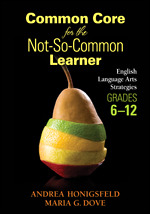Common Core for the Not-So-Common Learner, Grades 6-12
English Language Arts Strategies
New hope for our students who struggle most
Under the best of circumstances meeting the Common Core can be a challenge. But if you’re a teacher of academically or linguistically diverse students—and who isn’t these days—then that “challenge” may sometimes feel more like a “fantasy.” Finally, here are two expert educators who are brave enough, knowledgeable enough, and grounded enough to tackle this issue.
The grades 6-12 follow-up to Dove and Honigsfeld’s best-selling K-5 volume, this outstanding resource is packed with all the advice, tools, and strategies you need to build struggling learners’ language skills in today’s Common Core climate. Armed with this book, you’ll
- Better understand the 32 ELA anchor standards
- Learn more about the specific skills “uncommon learners” need to master them
- Discover new research-based teaching strategies aligned to each standard
- Maximize the effectiveness of collaboration and co-teaching
Read this book, implement its strategies, and see the benefits for yourself. It may be your best hope for making the standards achievable for all kinds of “uncommon learners”: ELLs, students with disabilities, speakers of nonstandard English, and other struggling students.
“Honigsfeld and Dove provide educators with research, insights, tools, and models for helping diverse students meet and exceed Common Core anchor literacy standards across disciplines. This book is a powerful guide for deepening classroom teaching practices and engaging in professional conversations that foster the enduring learning of content, language, and literacy.”
--Jeff Zwiers, Researcher,
Stanford University, CA
“Uncommon learners are more common in classrooms than you think. . . .Thankfully, Honigsfeld and Dove show us the way. They pave a path to high expectations that actually shows us how to get there. Filled with examples and ideas, this book will contribute in significant ways to the success that all learners have for decades to come.”
--Douglas Fisher, Professor,
San Diego State University, CA
"This amazingly thorough text is one you will return to many times to get just one more idea. Addressing the challenges of designing instruction that is sensitive to the Common Core State Standards, the authors offer thought-provoking, engaging examples that illustrate how to motivate even the most reluctant learner. Every educator or administrator who is trying to understand how to accommodate the needs of diverse learners in grades 6-12 will find this text an essential resource that supports accomplishing well articulated teaching points."
"Honigsfeld and Dove provide educators with research, insights, tools, and models for helping diverse students meet and exceed Common Core anchor literacy standards across disciplines. This book is a powerful guide for deepening classroom teaching practices and engaging in professional conversations that foster the enduring learning of content, language, and literacy."
"With this book the authors provide just the kind of resource that secondary teachers are yearning for as they navigate implementation of the Common Core State Standards. The emphasis on 'not-so-common' learners validates the unique needs these students bring to our schools and provides teachers with tools for assisting all students in becoming college and career ready. The specific ideas and strategies presented are invaluable!"
"Any reader will gain a clear picture of how the standards are designed and how the expectations progress across the grade levels from this accessible but comprehensive guide. The anchor standards in each domain are explained and paired with engaging, realistic classroom strategies shared by educators from across the country. Collaboration is a main theme in this positive, practical, and energizing text that will give educators the confidence to approach the Common Core Standards while meeting the needs of our diverse learners in the classroom."
"The Common Core State Standards have been adopted by many of the nation's states and it’s likely that more will join. Honigsfeld and Dove provide us with a clear road map for how to make the Standards come alive in our classrooms and schools. They also provide us with an important means to individually and collaboratively understand what is working and what needs improvement (a must in our work!). Their latest book should be a core text and must-read for all of us."
